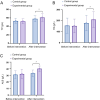Application of Short Peptide Enteral Nutrition in Mechanically Ventilated Critically Ill Children with Severe Pneumonia and Its Impact on Patient Recovery
- PMID: 39867286
- PMCID: PMC11762309
- DOI: 10.2147/IDR.S502880
Application of Short Peptide Enteral Nutrition in Mechanically Ventilated Critically Ill Children with Severe Pneumonia and Its Impact on Patient Recovery
Abstract
Objective: To explore the application of short-peptide enteral nutrition formulation in mechanically ventilated pediatric patients with severe pneumonia and its impact on rehabilitation outcomes, providing practical clinical evidence for the nutritional support strategy in critically ill pneumonia children.
Methods: This study retrospectively analyzed the clinical data of 90 neonatal pneumonia patients undergoing mechanical ventilation from May 2022 to December 2023. The patients were divided into an experimental group receiving short peptide enteral nutrition formulation via nasogastric tube and a control group receiving whole-protein enteral nutrition formulation via nasogastric tube. The nutritional risk was assessed using STRONGkids, and the nutritional status was analyzed through biochemical protein indicators. Additionally, mechanical ventilation time, hospitalization duration, incidence of ventilator-associated pneumonia (VAP), and disease outcomes were recorded and compared between the two groups.
Results: Both groups were assessed with medium to high nutritional risk, with no significant difference in the degree of nutritional risk (P > 0.05). After intervention, total protein, albumin, and prealbumin levels increased in both groups, with the experimental group showing significantly higher levels than the control group (P < 0.05). VAP predominantly occurred in the control group, with an incidence rate of 7% (3/45), showing a statistically significant difference between the two groups (P < 0.05). The experimental group exhibited significantly shorter Length of hospital stay and mechanical ventilation duration compared to the control group (P < 0.05). Moreover, there was no statistically significant difference in disease outcomes between the two groups (P > 0.05).
Conclusion: Short peptide enteral nutrition formulation contributes to improving the treatment outcomes of mechanically ventilated pneumonia patients, providing a therapeutic approach for the nutritional support of critically ill children requiring mechanical ventilation.
Keywords: mechanical ventilation; nutritional status; pediatric patients with severe pneumonia; short peptide enteral nutrition formulation.
© 2025 Xu et al.
Conflict of interest statement
The authors state that there are no conflicts of interest to disclose for this work.
Figures

Similar articles
-
[Nutritional support in children with pneumonia on mechanical ventilation by short-peptide enteral nutrition formula].Zhongguo Dang Dai Er Ke Za Zhi. 2020 Nov;22(11):1209-1214. doi: 10.7499/j.issn.1008-8830.2006101. Zhongguo Dang Dai Er Ke Za Zhi. 2020. PMID: 33172557 Free PMC article. Clinical Trial. Chinese.
-
Nasointestinal Tube in Mechanical Ventilation Patients is More Advantageous.Open Med (Wars). 2019 May 26;14:426-430. doi: 10.1515/med-2019-0045. eCollection 2019. Open Med (Wars). 2019. PMID: 31198856 Free PMC article.
-
[The dynamic monitoring of gastric residual volume by ultrasound was used to guide the early nutritional treatment of patients with severe mechanical ventilation to gradually achieve the standard].Zhonghua Wei Zhong Bing Ji Jiu Yi Xue. 2024 Feb;36(2):172-177. doi: 10.3760/cma.j.cn121430-20231008-00849. Zhonghua Wei Zhong Bing Ji Jiu Yi Xue. 2024. PMID: 38442934 Clinical Trial. Chinese.
-
Oral hygiene care for critically ill patients to prevent ventilator-associated pneumonia.Cochrane Database Syst Rev. 2020 Dec 24;12(12):CD008367. doi: 10.1002/14651858.CD008367.pub4. Cochrane Database Syst Rev. 2020. PMID: 33368159 Free PMC article.
-
Effect of a multidisciplinary nutrition management model in patients with critical illness: A randomized trial.Nurs Crit Care. 2024 Mar;29(2):417-426. doi: 10.1111/nicc.12988. Epub 2023 Nov 7. Nurs Crit Care. 2024. PMID: 37935453 Review.
References
LinkOut - more resources
Full Text Sources
Research Materials

